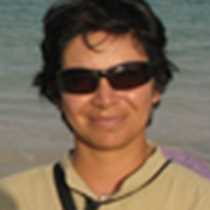Southern Isabela Island
Our morning exploration on the island of Isabela took place on a relatively new area. This uplifted piece of coastline is located at the bottom of Alcedo volcano, at the west central region of this immense island. The name of this area is Urvina Bay, and once on shore, we had a great time observing several species of Darwin finches during their courtship, mating, nesting and even foraging behavior, taking advantage of the seasonal abundance of food.
We were also surprised by the encounter of several tortoises along the trail, as well as some land iguanas. The latest ones, displaying their breeding colors and behaving aggressively; this is typical behavior for this time of the year, as the males constantly dispute territories to access more females and increase the chances for reproduction.
The endemic colorful sulfur butterflies brought more color to the lush vegetation, and we spotted them flying in unusual large numbers. They are the primarily responsible of the pollination of certain species, as they feed on the nectar of some endemic flowering plants, such as the Galápagos cotton.
After that wonderful walk, we jumped in the refreshing waters of the bay. This was a great treat, as the swimming felt really good, and took care of the intense hit that we were already experiencing during the walk.
Those who wanted to continue to explore a little more the coastline and its volcanic features took the kayaks option, while our younger guests had a lot of fun learning how to drive a Zodiac, under the experienced hands of our Zodiac drivers and naturalists.
For the afternoon we sailed to Punta Moreno, which looks like the landscape one might expect to have on another planet. Large fields of lava surrounded us like an engulfing ocean, and it seemed so recent, as if this lava had just erupted yesterday.
While walking in the middle of this enormous lava flow, brackish water pools came into view. A group of blue winged teals were swimming along side the greater flamingoes.
The view was already fantastic, but a group of Galápagos penguins standing right next to marine iguanas and sea lions made it even much better! We felt pretty much “ignored” by them, as we were only just a few feet away and they continued to mind their business putting little or no attention at all to our presence! Strange view was to have prickly pear cacti growing precisely where the penguins are found, but I guess that explain the Galápagos really well; rare creatures among an amazing landscape!
Our morning exploration on the island of Isabela took place on a relatively new area. This uplifted piece of coastline is located at the bottom of Alcedo volcano, at the west central region of this immense island. The name of this area is Urvina Bay, and once on shore, we had a great time observing several species of Darwin finches during their courtship, mating, nesting and even foraging behavior, taking advantage of the seasonal abundance of food.
We were also surprised by the encounter of several tortoises along the trail, as well as some land iguanas. The latest ones, displaying their breeding colors and behaving aggressively; this is typical behavior for this time of the year, as the males constantly dispute territories to access more females and increase the chances for reproduction.
The endemic colorful sulfur butterflies brought more color to the lush vegetation, and we spotted them flying in unusual large numbers. They are the primarily responsible of the pollination of certain species, as they feed on the nectar of some endemic flowering plants, such as the Galápagos cotton.
After that wonderful walk, we jumped in the refreshing waters of the bay. This was a great treat, as the swimming felt really good, and took care of the intense hit that we were already experiencing during the walk.
Those who wanted to continue to explore a little more the coastline and its volcanic features took the kayaks option, while our younger guests had a lot of fun learning how to drive a Zodiac, under the experienced hands of our Zodiac drivers and naturalists.
For the afternoon we sailed to Punta Moreno, which looks like the landscape one might expect to have on another planet. Large fields of lava surrounded us like an engulfing ocean, and it seemed so recent, as if this lava had just erupted yesterday.
While walking in the middle of this enormous lava flow, brackish water pools came into view. A group of blue winged teals were swimming along side the greater flamingoes.
The view was already fantastic, but a group of Galápagos penguins standing right next to marine iguanas and sea lions made it even much better! We felt pretty much “ignored” by them, as we were only just a few feet away and they continued to mind their business putting little or no attention at all to our presence! Strange view was to have prickly pear cacti growing precisely where the penguins are found, but I guess that explain the Galápagos really well; rare creatures among an amazing landscape!




